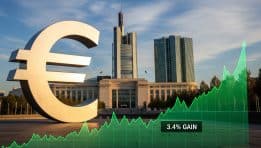The U.S. IPO market has long been a mirror of investor psychology, swinging between measured optimism and euphoric excess. Few statistics capture this dynamic as clearly as the average first-day gain of newly listed companies. Data compiled by Professor Jay Ritter, a leading academic authority on IPOs, demonstrates how market cycles and sentiment translate directly into first-day trading performance. The chart spanning from 1985 to the present shows dramatic spikes in certain years, most notably 1999 and 2000, coinciding with the peak of the dot-com bubble. The phenomenon underscores the interplay between supply, demand, and speculation in public equity markets.
By examining periods of extreme first-day gains, contrasting them with calmer years, and analyzing the forces at play, it becomes possible to understand not only the past but also the risks and opportunities of the IPO market today.
Historical Trends in First-Day Gains
From 1985 through the early 1990s, average first-day IPO gains remained modest, generally in the range of 5% to 10%. These levels reflected a balance between investor appetite and issuer pricing discipline. IPOs were typically underwritten by investment banks that prioritized long-term credibility with institutional investors over short-term excitement.
This balance began to shift in the mid-1990s, when gains crept upward, averaging closer to 15% to 20% in certain years. The heightened activity was driven by the rise of technology companies, which captured investor imagination with visions of transformative business models. Still, it was not until the final years of the decade that exuberance exploded into full view.
The years 1999 and 2000 stand apart. The average first-day gain in 1999 approached 70%, an extraordinary figure by historical standards. In 2000, the average remained above 50%. These numbers illustrate the speculative frenzy of the dot-com bubble, when investors bid up new issues to extraordinary levels, often with little regard for profitability or fundamentals. Many companies doubled in value on their first day of trading, despite lacking viable business models.
After the collapse of the dot-com bubble, the average first-day gains fell sharply. From 2001 through 2010, most years saw averages between 5% and 15%, reflecting a more subdued environment. Although notable IPOs like Google (2004) generated excitement, the overall market was more disciplined, scarred by the losses of the prior speculative excess.
The Modern Era: Renewed Surges
From the mid-2010s onward, IPO gains began to creep upward once again. By 2019, averages exceeded 20%, and in 2020 and 2021, the figures surged dramatically. In 2020, amid a flood of capital fueled by low interest rates and pandemic-driven liquidity, the average first-day gain climbed to around 40%. In 2021, it soared even higher, nearing 50%. This period echoed elements of the dot-com era, as investors rushed into growth-oriented companies, particularly in technology, biotech, and emerging sectors such as electric vehicles and fintech.
Unlike the dot-com bubble, however, many of the companies going public in the 2020s had meaningful revenues and in some cases profitability. Still, valuations often ran ahead of fundamentals, and post-IPO performance frequently disappointed. As interest rates rose in 2022 and 2023, many of these companies saw their stock prices collapse, echoing the boom-and-bust cycle of two decades earlier.
Forces Driving First-Day Gains
Several forces shape the magnitude of first-day IPO pops.
The first is underpricing, the practice by which underwriters set IPO offer prices below what the market is willing to pay. This serves to reward institutional investors who participate in the offering, ensuring that IPOs are oversubscribed and deemed successful. During periods of exuberance, issuers and underwriters deliberately leave more “money on the table,” creating outsized first-day returns.
The second is retail investor demand, which surges in times of speculative enthusiasm. When the broader public floods into IPOs, companies often see their shares bid up dramatically on debut. This was evident in both the dot-com bubble and the pandemic-era IPO boom.
The third is market liquidity. Loose monetary policy, low interest rates, and abundant capital in the system encourage risk-taking. Investors become more willing to pay up for growth stories, leading to larger first-day moves.
Finally, sector dynamics play a role. Periods dominated by hot sectors such as internet technology in 1999 or software-as-a-service in 2021 tend to feature higher average gains, as investors chase thematic exposure.
Irrational Exuberance and Market Psychology
The concept of irrational exuberance, famously coined by former Fed Chair Alan Greenspan in the 1990s, applies directly to IPOs. When first-day gains consistently exceed 40% or 50%, it suggests a market driven more by speculation than by sober assessment of future earnings. In such environments, issuers often rush to market, hoping to capitalize on elevated valuations before sentiment turns. This was evident in the flood of internet companies that went public in 1999 and 2000, as well as in the wave of listings during 2021.
In contrast, when average gains are closer to 10%, the market reflects greater pricing discipline. Issuers capture more value, underwriters maintain credibility, and investors make more measured bets. These calmer periods often follow crashes, as participants recalibrate expectations.
The Role of Regulation and Market Structure
Market structure has also influenced IPO outcomes over time. In the 1980s and 1990s, allocations were largely dominated by institutional investors with longstanding relationships with underwriters. The advent of electronic trading and retail brokerage apps has democratized access, allowing individual investors to participate more directly in IPOs. While this has increased inclusivity, it has also amplified volatility, as retail enthusiasm can drive prices sharply higher on debut.
Regulatory changes, including disclosure requirements and lockup rules, have also shaped behavior. Still, as the data suggest, no amount of regulation can fully insulate the market from waves of optimism and speculation.
Lessons for Today’s Market
The lesson from the historical record is clear: periods of extreme first-day gains rarely end well. Both the dot-com bubble and the pandemic-era IPO surge were followed by sharp corrections. While first-day gains excite investors and generate headlines, they are not a reliable indicator of long-term success. Many of the companies that enjoyed spectacular debuts in 1999 or 2021 struggled to sustain value, with share prices collapsing in the years that followed.
For long-term investors, focusing on fundamentals—revenue growth, profitability, competitive advantage—is far more important than chasing debut-day momentum. For issuers, the challenge is balancing the allure of a strong first-day performance with the need to capture value for existing shareholders.
Conclusion
The chart of average first-day gains in U.S. IPOs tells a story of cycles: steady discipline in normal years, wild exuberance in boom times, and recalibration in the aftermath of crashes. The peaks of 1999–2000 and 2020–2021 illustrate how investor psychology can overwhelm fundamentals, creating spectacular but unsustainable gains. As the IPO market continues to evolve, the key question is whether participants will heed these lessons or repeat the same patterns.
What remains certain is that IPOs will always serve as a window into the collective mindset of investors, oscillating between rational pricing and exuberant speculation.
Comparison, examination, and analysis between investment houses
Leave your details, and an expert from our team will get back to you as soon as possible
* This article, in whole or in part, does not contain any promise of investment returns, nor does it constitute professional advice to make investments in any particular field.
To read more about the full disclaimer, click here- sagi habasov
- •
- 11 Min Read
- •
- ago 54 seconds
 Americas Markets Close Mixed as Investors Balance Optimism and Currency Strength
Americas Markets Close Mixed as Investors Balance Optimism and Currency Strength
Markets across the Americas ended today’s trading session with a mixed performance, as investors assessed fresh economic data, currency fluctuations,
- ago 54 seconds
- •
- 11 Min Read
Markets across the Americas ended today’s trading session with a mixed performance, as investors assessed fresh economic data, currency fluctuations,
- Lior mor
- •
- 12 Min Read
- •
- ago 2 hours
 America’s Growing National Debt: Four Decades of Expansion and Its Future Implications
America’s Growing National Debt: Four Decades of Expansion and Its Future Implications
The U.S. national debt has become one of the defining issues of modern economic policy, central to debates in Washington
- ago 2 hours
- •
- 12 Min Read
The U.S. national debt has become one of the defining issues of modern economic policy, central to debates in Washington
- Ronny Mor
- •
- 13 Min Read
- •
- ago 4 hours
 Warning Signs in the Labor Market: Small Business Sales Weakness as a Leading Indicator for Rising U.S. Unemployment
Warning Signs in the Labor Market: Small Business Sales Weakness as a Leading Indicator for Rising U.S. Unemployment
The U.S. labor market has long been viewed as a cornerstone of economic strength, providing resilience even in times of
- ago 4 hours
- •
- 13 Min Read
The U.S. labor market has long been viewed as a cornerstone of economic strength, providing resilience even in times of
- orshu
- •
- 8 Min Read
- •
- ago 5 hours
 European Markets Close Mostly Lower Amid Cautious Investor Mood
European Markets Close Mostly Lower Amid Cautious Investor Mood
Stock markets finished today’s session largely in negative territory, as investors adopted a more cautious stance in response to soft
- ago 5 hours
- •
- 8 Min Read
Stock markets finished today’s session largely in negative territory, as investors adopted a more cautious stance in response to soft












